

0


0
FOOD
By Avantika Mehrotra
14 August, 2018
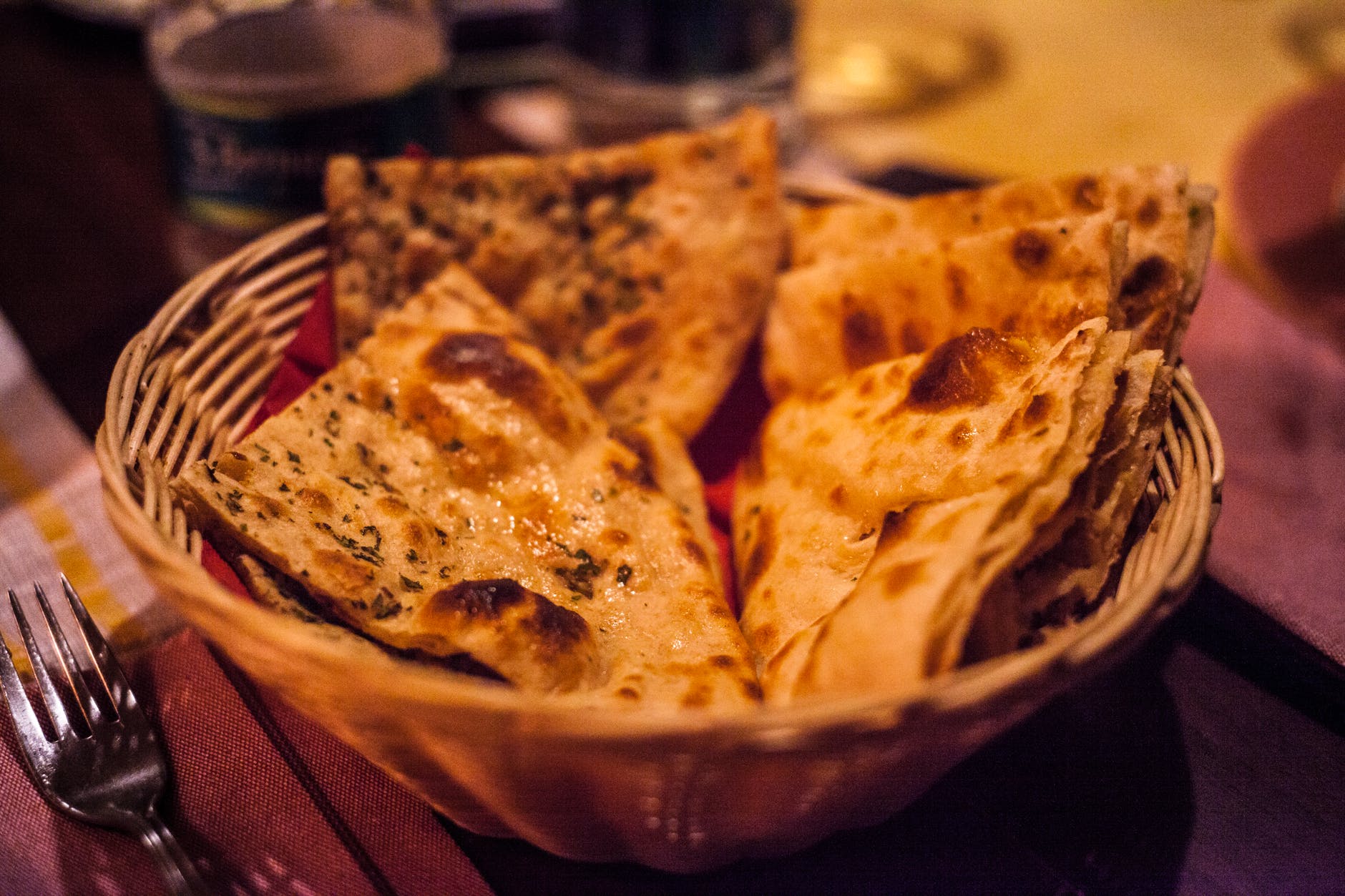
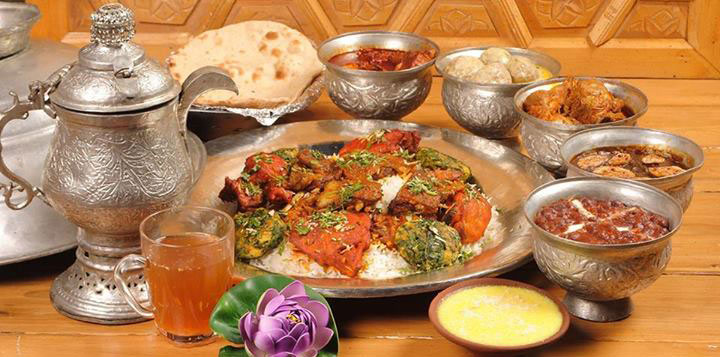 Food in Jammu and Kashmir is influenced by its climatic conditions. Non-vegetarian food includes meat, chicken, lamb and fish. Kashmiri Pundits, despite being Brahmins, consume meat.
Wazwan is a traditional 36-course meal served in marriages and on special occasions. It’s an art to cook this meal which is not taught but inherited. It starts with tash-t-nari( ritual washing of hands), followed by rice, seekh kebab, meeth maaz(methi korma) , tabak maaz( lamb ribs- braised with ground spices and milk first, then browned in butter), safed kokur ( chicken in white sauce), zafrani kokur( chicken in saffron sauce). Next course includes rista (meatballs in a red paprika-saffron-fennel spicy gravy), rogan josh, daniwal korma (lamb roasted with yogurt,spices,onion puree, coriander), aab gosh (lamb chunks cooked with a fennel based mixture , cardamom and partially evapourated milk), marchhwangan korma (chicken legs), and gushtaba( meatballs cooked in a spicy yogurt gravy). Gushtaba is a big meatball which means fullstop. Desserts are served last like phirni which is a milk pudding.
Food in Jammu and Kashmir is influenced by its climatic conditions. Non-vegetarian food includes meat, chicken, lamb and fish. Kashmiri Pundits, despite being Brahmins, consume meat.
Wazwan is a traditional 36-course meal served in marriages and on special occasions. It’s an art to cook this meal which is not taught but inherited. It starts with tash-t-nari( ritual washing of hands), followed by rice, seekh kebab, meeth maaz(methi korma) , tabak maaz( lamb ribs- braised with ground spices and milk first, then browned in butter), safed kokur ( chicken in white sauce), zafrani kokur( chicken in saffron sauce). Next course includes rista (meatballs in a red paprika-saffron-fennel spicy gravy), rogan josh, daniwal korma (lamb roasted with yogurt,spices,onion puree, coriander), aab gosh (lamb chunks cooked with a fennel based mixture , cardamom and partially evapourated milk), marchhwangan korma (chicken legs), and gushtaba( meatballs cooked in a spicy yogurt gravy). Gushtaba is a big meatball which means fullstop. Desserts are served last like phirni which is a milk pudding.
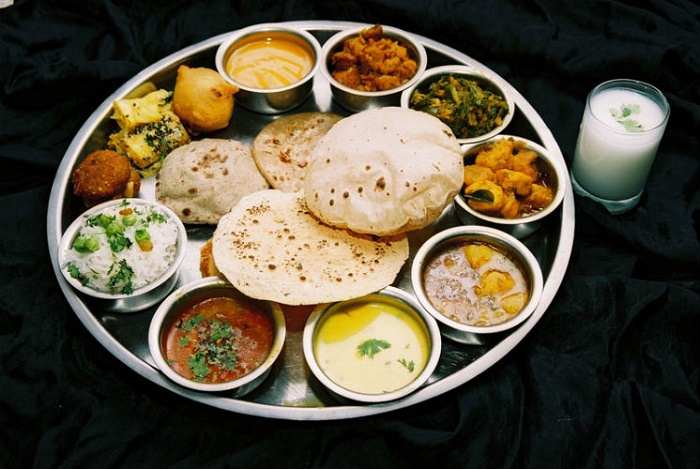 Primarily, a vegetarian state despite residing near to an extensive coastline doesn’t provide seafood due to the influence of Jainism. Most of the dishes have a sweet taste to them, even ones which are spicy. Whole lentils are a must.
Thali includes Raasawala Dhokla or any other form of dhokla as starters, followed by Bajra Bhakri/roti, Methi Thepla which is a flatbread made using fresh fenugreek leaves. Dal is sweet and sour with peanuts, Kadhi made with curd but slightly sweet, Moong Mag a curry with whole moong, Ringana Methi Nu Shak which is eggplant cooked with fenugreek leaves. Undhiyu is a mixed vegetable cooked in spinach paste, Khichidi, Chaas or buttermilk and finally the sweetdish, Gol Papdi, wheat flour based sweet.
Primarily, a vegetarian state despite residing near to an extensive coastline doesn’t provide seafood due to the influence of Jainism. Most of the dishes have a sweet taste to them, even ones which are spicy. Whole lentils are a must.
Thali includes Raasawala Dhokla or any other form of dhokla as starters, followed by Bajra Bhakri/roti, Methi Thepla which is a flatbread made using fresh fenugreek leaves. Dal is sweet and sour with peanuts, Kadhi made with curd but slightly sweet, Moong Mag a curry with whole moong, Ringana Methi Nu Shak which is eggplant cooked with fenugreek leaves. Undhiyu is a mixed vegetable cooked in spinach paste, Khichidi, Chaas or buttermilk and finally the sweetdish, Gol Papdi, wheat flour based sweet.
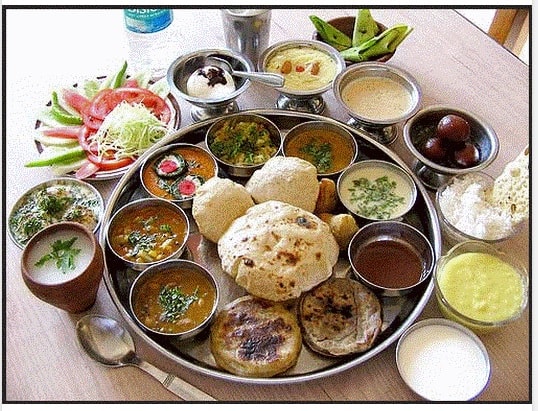 There is a specific way to arrange a thali here. At 12 o’ clock positioned at is salt and right next to it is a piece of lime. Snacks like Koliwada/ Sabudana wada/ Prawn or shrimp fritters; Koshimbir (Carrot Raddish Onion Salad) are served on the left side of the plate. All the curries like Kolhapuri style Egg curry, Palachi Peeth Perun Bhaji, Varan (a simple spicy dal) and dry vegetables are arranged on the right side of salt. Rice and roti served at 6 o’clock position. To balance the spice, lassi or mattha may be served. Basundhi is a speciality here which is basically thick milk with dry fruits. To finish off, we have Shreekand/ Modak/Puranpoli or Sheera.
Quite a few dishes are common between Gujrat and Maharashtra.
There is a specific way to arrange a thali here. At 12 o’ clock positioned at is salt and right next to it is a piece of lime. Snacks like Koliwada/ Sabudana wada/ Prawn or shrimp fritters; Koshimbir (Carrot Raddish Onion Salad) are served on the left side of the plate. All the curries like Kolhapuri style Egg curry, Palachi Peeth Perun Bhaji, Varan (a simple spicy dal) and dry vegetables are arranged on the right side of salt. Rice and roti served at 6 o’clock position. To balance the spice, lassi or mattha may be served. Basundhi is a speciality here which is basically thick milk with dry fruits. To finish off, we have Shreekand/ Modak/Puranpoli or Sheera.
Quite a few dishes are common between Gujrat and Maharashtra.
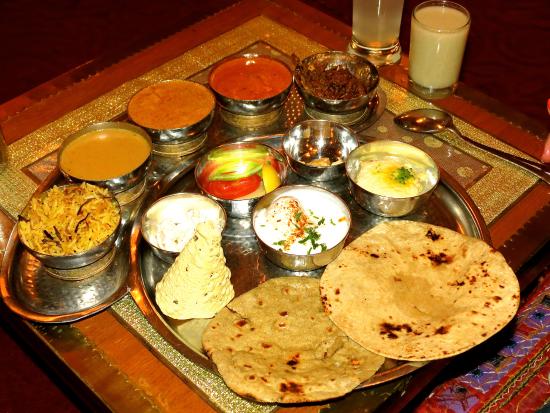 Being a dry state, people have learned to cook with milk, buttermilk, cream and curd to save water. The food is influenced by the war-like lifestyle of the Rajputs.
Dal Bati Churma is a complete meal in itself. Bati is small, round bread made of flour (plain or stuffed) and deep fried in ghee.
Other delicacies include Moong/ Panchmela Dal, Gatte Ki Sabzi ( besan nuggets boiled and cooked in a spicy curry), Bundi or Amras Ki Kadhi, Ker Sangria ( vegetable of a shrub berry and a bean), AAloo Ka Bharta, Mewa Pulao, Laal Maas (a yogurt-based mutton curry with hot spices and red chillies giving it the colour and name). The bread are made of Bajra, Makka and Jowar. Ghewar and Moong Dal Halwa are the sweets not to be missed.
Being a dry state, people have learned to cook with milk, buttermilk, cream and curd to save water. The food is influenced by the war-like lifestyle of the Rajputs.
Dal Bati Churma is a complete meal in itself. Bati is small, round bread made of flour (plain or stuffed) and deep fried in ghee.
Other delicacies include Moong/ Panchmela Dal, Gatte Ki Sabzi ( besan nuggets boiled and cooked in a spicy curry), Bundi or Amras Ki Kadhi, Ker Sangria ( vegetable of a shrub berry and a bean), AAloo Ka Bharta, Mewa Pulao, Laal Maas (a yogurt-based mutton curry with hot spices and red chillies giving it the colour and name). The bread are made of Bajra, Makka and Jowar. Ghewar and Moong Dal Halwa are the sweets not to be missed.
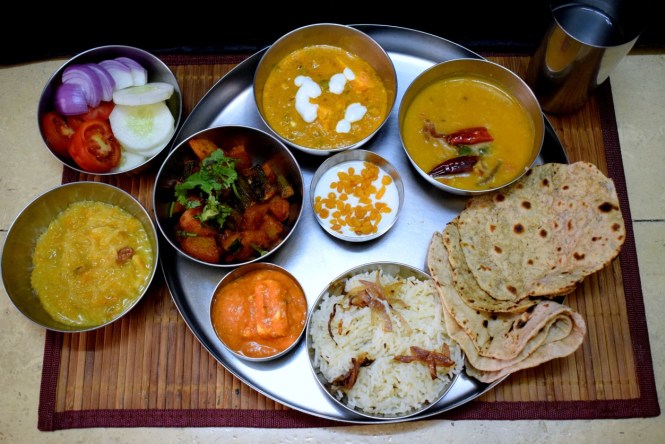 Punjab is known as the Breadbasket of India. The food here is rich and spicy made with a lot of dairy products and ghee. Tandoor style of cooking originated here. The thali may have Sarson Ka Saag served with Makke Ki Roti which is again a complete meal. Made from mustard greens and spices with spinach to enhance colour and thicken the dish topped with ghee.
Other signature dishes are the Pindi Chana which is chickpeas in a multitude of spices in onion tomato gravy, Stuffed Kulcha, Dal Makhni (whole black lentil, red kidney beans prepared in butter and cream), Butter Chicken- a yogurt and cream based chicken mildly spiced to sweet in taste, Tandoori Chicken- prepared by roasting chicken marinated in yogurt and spices in a cylindrical clay oven, Paneer Butter Masala, a vegetarian alternative to chicken and Raita to neutralise the spices. Gajar Ka Halwa- a carrot based pudding is to die for.
Punjab is known as the Breadbasket of India. The food here is rich and spicy made with a lot of dairy products and ghee. Tandoor style of cooking originated here. The thali may have Sarson Ka Saag served with Makke Ki Roti which is again a complete meal. Made from mustard greens and spices with spinach to enhance colour and thicken the dish topped with ghee.
Other signature dishes are the Pindi Chana which is chickpeas in a multitude of spices in onion tomato gravy, Stuffed Kulcha, Dal Makhni (whole black lentil, red kidney beans prepared in butter and cream), Butter Chicken- a yogurt and cream based chicken mildly spiced to sweet in taste, Tandoori Chicken- prepared by roasting chicken marinated in yogurt and spices in a cylindrical clay oven, Paneer Butter Masala, a vegetarian alternative to chicken and Raita to neutralise the spices. Gajar Ka Halwa- a carrot based pudding is to die for.
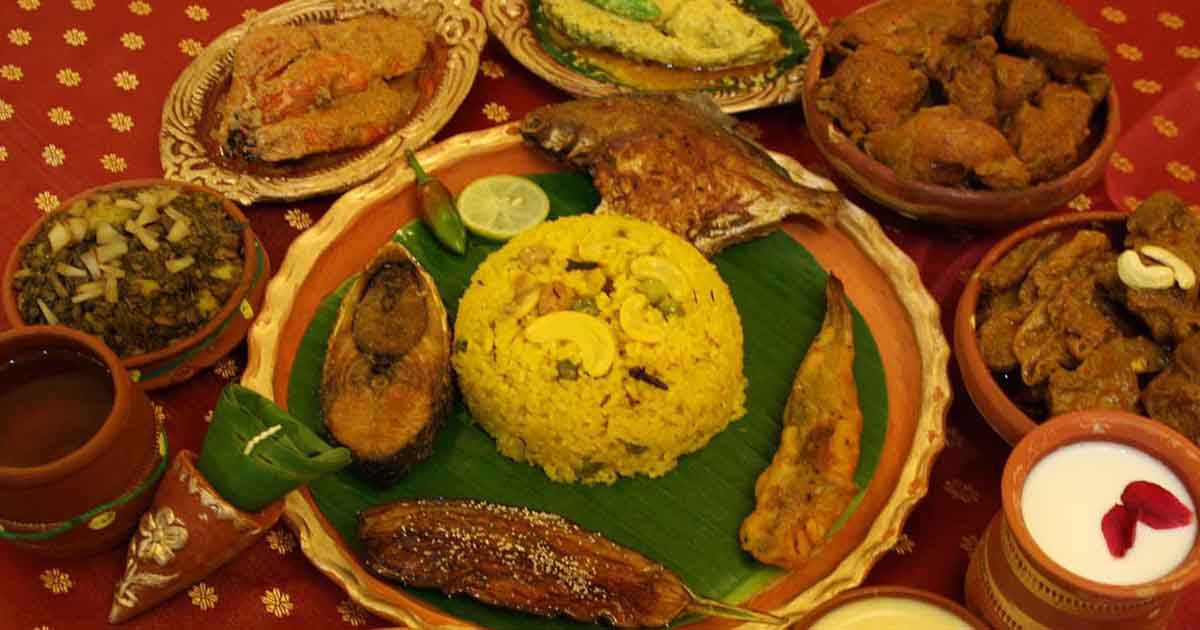 The first course has something bitter in it known to have cleansing properties like fried bittergourd known as Ucche or Begun Bhaja. Fried Rui- a fish, as snacks, followed by rice and dal ( Cholar dal which is chana dal tempered with spices or Chanar dal which is curdled from milk) and a seasonal vegetable. Aloo Poshto (potato in poppy seeds) is a simple but special dish. Bhetki Macher Paturi is mustard seed and coconut paste with fish wrapped in banana leaf, Chingri Macher Malaikari is prawn cooked in coconut milk gravy flavoured with spices, Doi Mach- a yoghurt based fish curry or paneer for vegetarians add to the exciting thali here. Misti Doi/ Roshogulla/ Patishapta/ Sandesh are sweets, all of which must definitely be tasted.
Please take special care to pronounce these sweets right or else you are bound to offend the Bengalis.
The first course has something bitter in it known to have cleansing properties like fried bittergourd known as Ucche or Begun Bhaja. Fried Rui- a fish, as snacks, followed by rice and dal ( Cholar dal which is chana dal tempered with spices or Chanar dal which is curdled from milk) and a seasonal vegetable. Aloo Poshto (potato in poppy seeds) is a simple but special dish. Bhetki Macher Paturi is mustard seed and coconut paste with fish wrapped in banana leaf, Chingri Macher Malaikari is prawn cooked in coconut milk gravy flavoured with spices, Doi Mach- a yoghurt based fish curry or paneer for vegetarians add to the exciting thali here. Misti Doi/ Roshogulla/ Patishapta/ Sandesh are sweets, all of which must definitely be tasted.
Please take special care to pronounce these sweets right or else you are bound to offend the Bengalis.
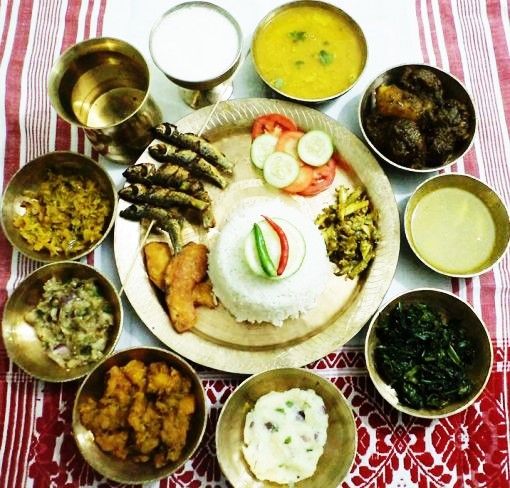 They use very fewer spices and simple cooking is done with the use of fresh veggies or fermented products. Khar Tenga is made with dried banana skin, Pura is barbequed/ smoked meat or fish, Poita bhat is rice soaked in buttermilk overnight and garnished with mustard oil, onion, chilli, etc. Mashed potatoes mixed in mustard oil with onion and green chillies, Bor or fritters served along with beer to drink complete the meal. Betel leaves are offered to finish off.
They use very fewer spices and simple cooking is done with the use of fresh veggies or fermented products. Khar Tenga is made with dried banana skin, Pura is barbequed/ smoked meat or fish, Poita bhat is rice soaked in buttermilk overnight and garnished with mustard oil, onion, chilli, etc. Mashed potatoes mixed in mustard oil with onion and green chillies, Bor or fritters served along with beer to drink complete the meal. Betel leaves are offered to finish off.
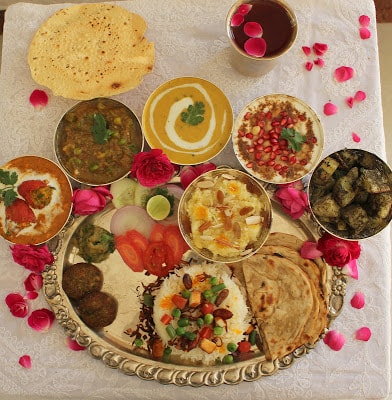 Famous for its Dum style of cooking (slow, covered cooking over a low fire) invented by the rakabdars. A variety of kebabs like Galouti / Shami / Kakori / Boti/ Seekh each with their own special taste and flavour form the starters. Sultani dal is as royal as it sounds with cream, saffron and spices. Navratan/ Shahi Korma is a rich creamy dish which literally translates into a nine-gem curry, with the gems being fruits, vegetables and nuts. Mattar ka nimmona is green peas made into a curry with lentil dumplings. For meat lovers, there are choices of chicken/ mutton kormas and biryanis in dum pukht style. A variety of bread to go with are sheermal, warqi parathas, roomali roti, etc. Nawabi pulao is vegetable pulao garnished with saffron, roasted almonds and cashews. Nihari Kulcha is again a full dish of mutton gravy with kulcha. To end with a variety of sweets to choose from like halwa or the famous malai gilori or even kulfi faluda. Chaat also has its origin here and you just cannot miss the basket chaat.
Famous for its Dum style of cooking (slow, covered cooking over a low fire) invented by the rakabdars. A variety of kebabs like Galouti / Shami / Kakori / Boti/ Seekh each with their own special taste and flavour form the starters. Sultani dal is as royal as it sounds with cream, saffron and spices. Navratan/ Shahi Korma is a rich creamy dish which literally translates into a nine-gem curry, with the gems being fruits, vegetables and nuts. Mattar ka nimmona is green peas made into a curry with lentil dumplings. For meat lovers, there are choices of chicken/ mutton kormas and biryanis in dum pukht style. A variety of bread to go with are sheermal, warqi parathas, roomali roti, etc. Nawabi pulao is vegetable pulao garnished with saffron, roasted almonds and cashews. Nihari Kulcha is again a full dish of mutton gravy with kulcha. To end with a variety of sweets to choose from like halwa or the famous malai gilori or even kulfi faluda. Chaat also has its origin here and you just cannot miss the basket chaat.
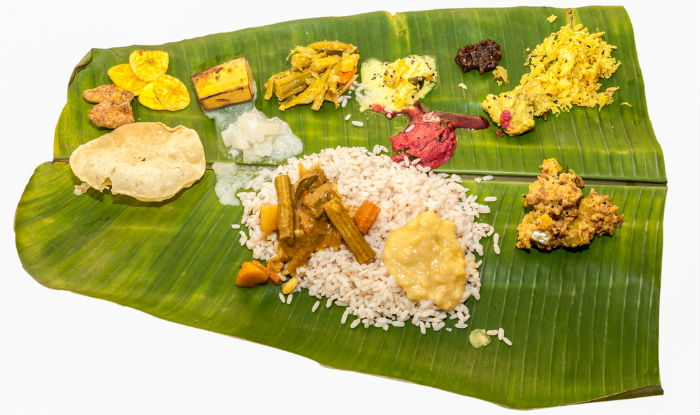 Known as the Land of Spices, Kerala’s cuisine has served both vegetarian and no-vegetarian. Traditional food is vegetarian but with a lot of Muslims and Christians now, non-vegetarian dishes are in abundance.
Kerala Sadya:- Upto 30 dishes are served as a single course meal. It is an elaborate vegetarian banquet for special occasions like marriages and festivals, served on a banana leaf. Grated coconut and its milk are used for thickening and flavouring dishes. It includes pappadam, pickles, and a variety of veggies. Bittergourd Thoran-a dish of sautéed vegetables as green peas, beans, jackfruit, carrots, cabbage; Avial is a thick mixture of various vegetables and coconut, Kaalan is made of yogurt, coconut and any one vegetable, Sambhar is a thick gravy made of lentils, vegetables like drumstick and tamarind, Rasam- a watery, spicy dish which aids digestion, Parippu- a thick curry lentil dish, Buttermilk, Boiled rice, Appam with stew, Erissery is pumpkin and lentil curry, Koottukari is banana cooked with chickpeas, Kichadi (sour curry made of yogurt and sliced cucumber), Pachadi is a sweet form of kichadi made with pineapple, pumpkin, grapes in yogurt are the main dishes served in this feast. Banana Fritters are also to be tried. A banana is always served, to be eaten with paysam or dessert. Prathaman is a sweet thick liquid with a variety of ingredients made with jaggery and coconut milk to finish off. The dishes are all cooked in coconut oil.
I personally could survive on Tender coconut though nowadays it’s freely available even in the north and not just the coastal areas.
Known as the Land of Spices, Kerala’s cuisine has served both vegetarian and no-vegetarian. Traditional food is vegetarian but with a lot of Muslims and Christians now, non-vegetarian dishes are in abundance.
Kerala Sadya:- Upto 30 dishes are served as a single course meal. It is an elaborate vegetarian banquet for special occasions like marriages and festivals, served on a banana leaf. Grated coconut and its milk are used for thickening and flavouring dishes. It includes pappadam, pickles, and a variety of veggies. Bittergourd Thoran-a dish of sautéed vegetables as green peas, beans, jackfruit, carrots, cabbage; Avial is a thick mixture of various vegetables and coconut, Kaalan is made of yogurt, coconut and any one vegetable, Sambhar is a thick gravy made of lentils, vegetables like drumstick and tamarind, Rasam- a watery, spicy dish which aids digestion, Parippu- a thick curry lentil dish, Buttermilk, Boiled rice, Appam with stew, Erissery is pumpkin and lentil curry, Koottukari is banana cooked with chickpeas, Kichadi (sour curry made of yogurt and sliced cucumber), Pachadi is a sweet form of kichadi made with pineapple, pumpkin, grapes in yogurt are the main dishes served in this feast. Banana Fritters are also to be tried. A banana is always served, to be eaten with paysam or dessert. Prathaman is a sweet thick liquid with a variety of ingredients made with jaggery and coconut milk to finish off. The dishes are all cooked in coconut oil.
I personally could survive on Tender coconut though nowadays it’s freely available even in the north and not just the coastal areas.
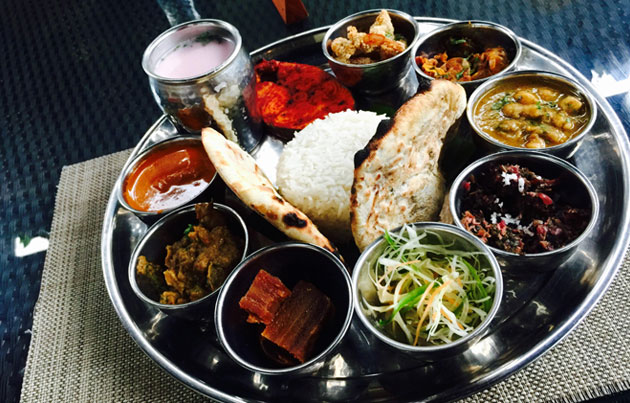 Tropical climate influences the use of spices and flavours. The cuisine is seafood based (crabs, lobster, squid, mussels). Tamarind and Kokum are freely used. Humman is fish curry and rice, Fish Suke, Fish Udid Methi is a curry made of fenugreek and mackerel, Kismur is a dry fish salad, Dongar or fish cutlets, Bhaji or Shak, Tondak- made with red cowpeas are the delicacies served here.
For more interesting content, Like our Facebook page, Follow us on Twitter, and Subscribe to our digital magazine BananiVista.
Tropical climate influences the use of spices and flavours. The cuisine is seafood based (crabs, lobster, squid, mussels). Tamarind and Kokum are freely used. Humman is fish curry and rice, Fish Suke, Fish Udid Methi is a curry made of fenugreek and mackerel, Kismur is a dry fish salad, Dongar or fish cutlets, Bhaji or Shak, Tondak- made with red cowpeas are the delicacies served here.
For more interesting content, Like our Facebook page, Follow us on Twitter, and Subscribe to our digital magazine BananiVista.